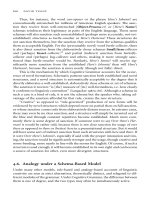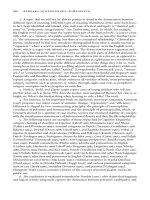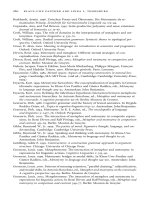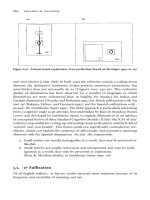Handbook of EEG interpretation - part 5 potx
Bạn đang xem bản rút gọn của tài liệu. Xem và tải ngay bản đầy đủ của tài liệu tại đây (1.64 MB, 29 trang )
FIGURE 4.8. Infantile spasm noted in second 7 above with an electrodecre-
mental response obtained in a 3-year-old child with tuberous sclerosis. Note
the high amplitude.
I
nfantile spasms are brief tonic spasms that involve head flexion and
arm abduction and extension for seconds, usually occurring in clus-
ters between 1 and 3 years of age. There are several forms that may
occur depending upon the degree of somatic involvement, and are typ-
ically associated with mental impairment. The spasms begin with an
abrupt generalized electrodecremental response on EEG with general-
ized attenuation of the background frequencies which may have faster
frequencies superimposed lasting from <1 sec to several seconds.
CHAPTER 4
104
FIGURE 4.9. Tonic seizure in a patient with Lennox-Gastaut syndrome.
T
onic seizures are associated with symptomatic generalized
epilepsy and are the most common seizure type associated with
the Lennox-Gastaut syndrome. Tonic seizures typically have an
abrupt onset of a generalized 10-Hz rhythm on EEG. Generalized
paroxysmal fast activity is often seen as the associated features on
EEG, although it may have no apparent clinical features associated
with brief bursts that occur during sleep. Low-voltage fast frequencies
associated with a generalized attenuation of the background may also
be evident during a tonic seizure.
Seizures
105
Focal seizures have a wide variety of EEG abnormalities that may occur depending
upon the location of the epileptogenic zone generating the ictal discharge. Some
focal seizures have no detectable representation at the surface of the scalp recorded
EEG. Furthermore, some focal seizures have an ictal pattern that is diffuse and
appear falsely “generalized” in distribution or even appear with subtle or without
detectable clinical features.
FIGURE 4.10. The above EEG shows a simple partial seizure that occurred
out of stage 2 sleep.
S
imple partial seizures are partial seizures that do not involve
impairment of consciousness and when associated with clinical
features reflect the aura. Most patients with mesial temporal lobe
epilepsy report an aura. However, while auras are nonspecific, expe-
riential, or viscerosensory symptoms including rising epigastric sensa-
tions, “butterflies,” nausea, fear, and deja vu are common. Despite the
presence of clinical symptoms, auras may be detected by scalp EEG
only approximately 40% of the time on routine recording.
CHAPTER 4
106
FOCAL SEIZURES
FIGURE 4.11. Right temporal 6- to 7-Hz rhythmic ictal theta discharge at
seizure onset in a patient with temporal lobe epilepsy.
M
esial temporal lobe seizures are the most common adult seizure
type, presenting as a complex partial seizure that involve
impairment of consciousness. Interictal EEG manifestations include
anterior temporal spikes at 0.5 to 1.5 Hz or rhythmic 2 to 4 Hz facil-
itated by drowsiness and light non-REM sleep. A frequent ictal pat-
tern of mesial temporal origin is the sudden appearance of localized
or regional background attenuation, build-up of 4- to 7-Hz rhythmic
activity, increasing in amplitude as it slows to 1 to 2 Hz. This may be
followed by suppression or slow activity.
Seizures
107
FIGURE 4.12. Left temporal neocortical seizure onset with rhythmic 3-Hz
delta maximal in the mid-temporal derivation prior to rapid generalization.
L
ateral or neocortical temporal seizures differ from those that
begin in the mesial portion of the temporal lobe. Although it may
be difficult to clinically distinguish neocortical temporal lobe seizures
from mesial temporal lobe seizures, they may have a widespread
hemispheric onset, begin in the mid-temporal derivations at <5 Hz,
have rapid propagation to extratemporal structures, and have a
greater likelihood to secondarily generalize as seen above. It is also
not uncommon to have a bilateral ictal onset noted on EEG with neo-
cortical temporal lobe seizure onset.
CHAPTER 4
108
FIGURE 4.13. Temporal lobe seizure onset falsely localizing to the right
frontal region on scalp EEG. Note the initial alpha frequencies that persist in
the theta range.
S
ome patients with temporal lobe epilepsy (TLE) may have pro-
jected rhythms to the anterior head regions. In the above exam-
ple, a right anterior temporal lobe lesion was seen and created the
appearance of a right frontal discharge initially present as a burst of
repetitive spikes that evolved to an irregular right fronto-temporal
theta rhythm. The patient has been seizure free after right temporal
lobectomy for 2 years.
Seizures
109
FIGURE 4.14. Right “focal” temporal seizure confined to the right subtem-
poral (RST) 1 to 3 electrodes on intracranial recording. L(R)ST = left (right)
subtemporal; L(R)LT = left (right) lateral temporal; L(R)OF = left (right)
orbitofrontal.
P
artial seizures may originate from one to two electrodes at seizure
onset. Those seizures with a “focal” origin on the intracranial
EEG imply a restricted generator adjacent to the recording electrode.
In Figure 4.14, RST1 demonstrated an abrupt onset of rhythmic ictal
frequencies >13 Hz prior to RST1-3 repetitive spiking that remained
a well-localized unilateral discharge for 20 sec prior to contralateral
involvement of the left hemisphere. The “focal” onset, location, and
prolonged unilateral involvement prior to propagation are favorable
features for localizing seizures onset. Following right temporal lobec-
tomy, the patient has remained seizure free.
CHAPTER 4
110
FIGURE 4.15. Right “regional” temporal onset noted in the RST and RLT
subdural strip electrodes. L(R)ST = left (right) subtemporal; L(R)LT = left
(right) lateral temporal; L(R)OF = left (right) orbitofrontal.
R
egional onsets in patients with temporal lobe epilepsy identified
by intracranial electrodes demonstrate more widespread areas of
ictal onset. Lateralization and regionalization of the ictal activity are
then complementary to the remaining parameters of the presurgical
evaluation to demonstrate concordance for the purposes of epilepsy
surgery. In the above EEG, note the large sharply contoured slow
wave and regional attenuation in the RST and RLT strips and rhyth-
mic ictal fast activity in RST 1 and 2 at seizure onset.
Seizures
111
FIGURE 4.16. Discrete focal seizure onset in a patient with a right frontal
lesion. (Courtesy of Imran Ali, MD.)
F
requently because much of the frontal lobe is underrepresented by
scalp electrodes, ictal recordings in frontal lobe epilepsy are asso-
ciated with nonlocalized and often nonlateralized ictal EEG on scalp
recording. Anterior and dorsolateral onset may be associated with
focal IEDs and even focal electrographic seizures, although this is typ-
ically observed when scalp ictal EEG changes are evident. Note the
infrequently seen focal ictal onset in the patient above with lesional
frontal lobe epilepsy evident at FP1.
CHAPTER 4
112
FIGURE 4.17. Nonlocalized ictal EEG in frontal lobe epilepsy. Notice the
brief right frontal-central repetitive spikes in seconds 7 to 8.
F
rontal lobe epilepsy often has very brief, bizarre, bimanual-
bipedal automatisms with nocturnal predominance and be prone
to acute repetitive seizures and status epilepticus. It is the second more
common location in large epilepsy surgery series. Ictal scalp EEG is
often of limited utility. In orbitofrontal and mesial frontal onset,
seizures may have no representation at all or be obscured by an over-
riding muscle artifact to make scalp EEG “invisible” during the
seizure. Interictal epileptiform discharges are notably absent in 30%
of patients with frontal lobe epilepsy. Orbitofrontal and mesial frontal
may not manifest interictal or even ictal discharges at all. Midline
electrodes are crucial in cases of mesial frontal origin.
Seizures
113
FIGURE 4.18. Diffuse electrodecremental response in a patient with a sup-
plementary motor seizure.
S
upplementary motor seizures are seizures that begin in the mesial
frontal lobe and therefore often may have brief and bizarre semi-
ologies that mimic psychogenic nonepileptic seizures (pseudo-pseudo-
seizures). The clinical semiology may also manifest a “fencer’s”
posture that provides more localizing value than surface ictal EEG
(see above) with the side of tonic extension reflecting the side oppo-
site seizure onset.
CHAPTER 4
114
FIGURE 4.19. The tracing shows high-frequency, mu-like arcuate wave-
forms focally over the left parietal C3-P3 derivations at 10 Hz in the region of
a brain tumor.
P
arietal lobe seizures are often clinically silent. Somatosensory
involvement may yield a perception of tingling, formication, pain,
heat, movement, or dysmorphopsia, typically of the distal limb or
face. As in frontal lobe epilepsy, only a small number of those with
parietal ictal onset are focal. Spread may occur to the supplementary
motor area or temporal area and result in electrographic lateralization
or even localization late in the seizure onset. The patient above noted
paroxysmal right arm and leg tingling during the recording.
Seizures
115
FIGURE 4.20. Right occipital lobe seizure with a build-up of right occipital
6- to 7-Hz rhythmic ictal theta associated with the patient’s complaint of left
visual field loss.
O
ccipital lobe seizures commonly manifest phosphenes, unformed
visual hallucinations, and less frequently blindness and hemi-
anopsia. There may be illusions that objects appear larger (macrop-
sia), smaller (micropsia), distorted (metamorphopsia), or persistent
after the visual stimulus (pallinopsia). High-frequency discharges at
the temporoparieto-occipital junction can induce contraversive nys-
tagmus and eye and head deviation. The EEG may show build-up of
rapid alpha-beta activity focally over the temporoparieto-occipital
junction or more posteriorly (see above), often with spread anteriorly
to temporal structures as the seizure progresses from simple partial to
complex partial semiology.
CHAPTER 4
116
FIGURE 4.21. Subclinical seizure in a patient with encephalopathic general-
ized epilepsy. There were no clinical signs noted during multiple brief seizures.
S
ubclinical seizures are an artifact of testing with the degree of
“subclinical” occurrence reflecting the sophistication of behav-
ioral testing. Seizures may occur without awareness or be very subtle
such that clinical signs are not noted. These are especially common in
patients with complex partial seizures. When testing is performed,
some seizures exhibit no evidence of interruption in behavior. Such is
the case with brief absence seizures. In the patient above with
encephalopathic generalized epilepsy, the seizures were unassociated
with any clinical signs despite behavioral testing (counting).
Seizures
117
FIGURE 4.22. Multiple electrode artifacts simulating IEDs in a patient with
psychogenic non-epileptic seizures (PNES).
FIGURE 4.23. “Ictal” EEG in a PNES. Note the evolution of the rhythmic
myogenic artifact that occurred with repetitive jaw movement mimicking an
epileptic seizure.
A
s expected, the EEG during a nonepileptic seizure is normal. The
importance of defining seizures as epileptic or nonepileptic is
reflected in the number of patients with PNES. While the precise inci-
dence is undefined, they account for 20% to 25% of admissions to
hospital- based epilepsy monitoring units and are about as prevalent
as multiple sclerosis.
CHAPTER 4
118
Overinterpretation of EEG patterns that are normal is a common
substrate for misdiagnosis. An artifact may also be the culprit leading
to a false diagnosis of epilepsy, as in the example above (compare the
similarity in “pseudoevolution” to Figure 4.7).
Seizures
119
ADDITIONAL RESOURCES
Benbadis SR. The EEG of nonepileptic seizures. J Clin Neurophsyiol 2006;23:
340–352.
Blume WT, Holloway GM, Wiebe S. Temporal epileptogenesis: localizing value
of scalp and subdural interictal and ictal EEG data. Epilepsia
2000;42:508–514.
Farrell K, Tatum WO. Enecphalopathic generalized epilepsy and Lennox-
Gastaut syndrome. In: Wyllie E, ed. The Treatment of Epilepsy; Practice
and Principals. 4th ed. Baltimore, Lippincott Williams & Williams,
2006:429–440.
Foldvary N, Klem G, Hammel J, et al. The localizing value of ictal EEG in
focal epilepsy. Neurology 2001;57:2022–2028.
Pacia SV, Ebersole JS. Intracranial EEG substsrates of scalp ictal patterns from
temporal lobe foci. Epilepsia 1997;38:642–654.
So, EL. Value and limitations of seizure semiology in localizing seizure onset.
J Clin Neurophysiol 2006;23:353–357.
Tatum WO IV. Long-term EEG monitoring: a clinical approach to electrophys-
iology. J Clin Neurophysiol 2001;18(5):442–455.
Verma A, Radtke R. EEG of partial seizures. J Clin Neurophysiol 2006;23:
333–339.
Westmoreland BF. The EEG findings in extratemporal seizures. Epilepsia
1998;39(Suppl 4):S1–S8.
CHAPTER 4
120
121
CHAPTER 5
Patterns of
Special
Significance
WILLIAM O. TATUM, IV
SELIM R. BENBADIS
AATIF M. HUSAIN
PETER W. KAPLAN
M
any patterns of special significance are recorded in the
intensive care unit (ICU) in patients that are critically ill
with or without seizures. Nonepileptic encephalopathic
recordings as well as those that are epileptiform occur in addition to
those that include both forms with dynamic transition. In stupor and
coma, slower waveforms are seen that are morphologically different
than those that are seen during sleep. With greater depths of coma,
EEG typically reflects a greater degree of worsening, although pro-
gression is different in different individuals and most patterns are non-
specific. However, some patterns have special prognostic significance
and will be represented in the following section. The interictal-ictal
continuum has been best elucidated in the study of status epilepticus
(SE). This chapter will serve as a supplement to previous topics (see
Chapters 2–4). Patterns of severe encephalopathies often associated
with stupor or coma as well as SE will be illustrated. In coma, EEG
may be useful to quantify the degree of cerebral dysfunction, help
localize an abnormality, or assist with etiology in addition to nonin-
vasively following clinical or response to treatment. While many
encephalopathic forms of special significance are infrequently seen, SE
is common and deserves special mention.
The diagnosis of SE has largely been clinical, particularly with
convulsive status epilepticus (CSE). The EEG has shown great prom-
ise with the advent of long term monitoring (LTM) in cases with
impaired consciousness. Frequently, readily identifiable clinical fea-
tures are less apparent to observers, thus increasing the importance of
EEG in the ongoing management of the stuporous or comatose
patient in intensive care settings. Nonconvulsive events such as eye
blinking and deviation, nystagmus, face and limb myoclonus, staring,
or subtle mental status changes depend on the use of EEG in diagnos-
ing and classifying these as nonconvulsive SE. No particular EEG pat-
tern is representative for the clinical type of seizure or SE depicting it
as convulsive or nonconvulsive. SE represents the temporal extension
of individual seizures, and therefore the type of SE reflects the various
types of epileptic seizures with their different EEG patterns. Similar to
the seizure types previously demonstrated in Chapter 4, the EEG clas-
sification of SE can be divided into generalized and focal patterns.
Intermediate examples may occur, with the evolution of a focal to a
generalized pattern, or the reverse. This spread of seizure activity may
exhibit an evolution in spatial spread, discharge amplitude, and fre-
quency throughout the course of SE. Between individual discharges,
there may be preservation (or conversely ablation) of background
activity. Patterns may exhibit continuous or discontinuous features.
Periodic discharges (PDs) may be seen focally or bilaterally in a vari-
ety of patterns associated with seizures and SE. When PDs are pres-
ent, they may appear synchronous, or have independent hemispheric
periodicity. The EEG of SE typically contains individual discharges.
These may wax and wane and occur in a frequency of less than every
several seconds to >3/sec. They may contain spike, sharp wave, poly-
spike morphologies, or mixtures of these features. The morphologies
may occur focally, regionally, or in a generalized distribution.
CHAPTER 5
122
Periodic patterns are characterized by repetitive waveforms that often appear as
being epileptiform and recur in a persistent, regular, and periodic (or pseudoperi-
odic) fashion.The etiology for periodic patterns is nonspecific, although, when iden-
tified bilaterally, they usually reflect an acute or subacute, diffuse, encephalopathic
process.When identified unilaterally, they often reflect a focal structural manifesta-
tion when lateralized and persistent. Some of the periodic patterns (periodic later-
alized epileptiform discharges [PLEDs], bilateral PLEDs [BiPLEDs], generalized
periodic epileptiform discharges [GPEDs]) may appear in patients with stupor and
coma. Morphology, field of involvement, and reactivity are important in quantifying
the patterns within the context of the state of consciousness. Discharges that repeat
at regular intervals are periodic or pseudoperiodic and may reflect the continuum
of epileptiform abnormality or epileptic encephalopathies that have the potential for
manifesting seizures.These patterns may suggest more specific diagnoses when the
patterns on EEG have characteristic features.The addition of movement monitors
may help document a relationship in individuals between a periodic pattern and a
clinical manifestation such as myoclonic jerks.
An interictal-ictal transition is represented within an indistinct spectrum of
electrographic findings that may often times overlap (i.e., PLEDs).An electrographic
seizure is not simply the repetition of interictal epileptiform discharges (IEDs) as is
the case with the 3-Hz spike-and- wave pattern associated with idiopathic general-
ized epilepsy. Neither is it typically the prolongation of an interictal discharge, such
as a polyspike, as in the case of generalized paroxysmal fast activity (GPFA) in
patients with tonic seizures and symptomatic generalized epilepsy.
Patterns of Special Significance
123
PERIODIC EPILEPTIFORM DISCHARGES
FIGURE 5.1. Frequent asymptomatic left temporal spike-and-slow waves in
localization-related epilepsy (LRE).
W
hen IEDs repeat themselves, symptoms may or may not arise,
and repetitive IEDs are an infrequent ictal pattern as seen on
EEG during seizures. Above is an individual with epilepsy who is
asymptomatic at the time of the EEG recording despite the almost
continuous repetitive IEDs (see Chapter 4 for similar features with
symptoms).
CHAPTER 5
124
FIGURE 5.2. Left temporal PLEDs in a patient with left temporal lobe
epilepsy immediately following serial complex partial seizure.
P
eriodic lateralized epileptiform discharges (PLEDs) are character-
istically seen in acute (or subacute), pathological processes asso-
ciated with a unilateral hemispheric structural lesion. However,
PLEDs may appear as a physiological condition exacerbated by
chronic conditions such as following seizures or rarely migraine. This
periodic pattern is usually transient, typically disappearing in weeks.
PLEDs are an interictal phenomenon, although they may be ictal
when frequent and/or associated with rhythmic ictal discharges (see
below). Partial-onset seizures occur in >70% of patients with PLEDs
during their course.
Patterns of Special Significance
125
FIGURE 5.3. Left temporal PLEDs plus in a patient with an acute occipital
ischemic infarction. Note the rhythmic ictal discharge abutting the discharge.
P
LEDs plus may occur in the form of spikes, polyspikes, or sharp
biphasic or triphasiform discharges with or without slow waves
that repeat at regular periodic intervals. They typically appear in con-
junction with an encephalopathy (with a diffusely slow background).
Acute cerebral infarction or hemorrhage, tumors, anoxia, and central
nervous system infections may evoke PLEDs, although they are non-
specific in etiology. Consciousness is impaired ranging from mild
encephalopathy to coma. Status epilepticus is more commonly associ-
ated with PLEDs plus than with PLEDs (proper).
CHAPTER 5
126
FIGURE 5.4. Generalized periodic epileptiform discharges. This ictal pat-
tern followed a prolonged seizure. Note the high amplitude of the discharges.
G
eneralized periodic epileptiform discharges (GPEDs) are most
often associated with encephalopathy (see above) and typically
occur as an epiphenomena of a severe bilateral disturbance of cerebral
dysfunction. However, GPEDs may appear as an ictal correlate when
seizures are clinically evident. When GPEDs represent an ictal corre-
late, the state of the patient is less altered, a clinical presentation with
seizures (not myoclonus) may be evident, and a visible background
may be better visualized. See next section on stupor and coma.
Patterns of Special Significance
127
FIGURE 5.5. Right temporal PLEDs in a patient with herpes encephalitis
and nonconvulsive SE recorded in the ICU.
T
he hallmark of herpes simplex encephalitis (HSE) is the presence of
pseudoperiodic slow complexes or PLEDs in the setting of symp-
toms that suggest a central nervous system infectious disease. Initially a
diffusely slow background is seen that within the first week manifests
the periodic pattern. They are characteristically unilateral, but may be
bilateral and independent and temporal in predominance. The dis-
charges recur with a period of 1.0 to 2.5 sec and abate after weeks.
CHAPTER 5
128









